Military Police of Rio de Janeiro State
| State Police of Rio de Janeiro Polícia Militar do Estado do Rio de Janeiro | |
| Abbreviation | PMERJ |
| | |
| Blazon of the Military Police of Rio de Janeiro State | |
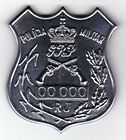 | |
| Old badge of the Military Police of Rio de Janeiro State | |
| Motto | To serve and protect Servir e proteger |
| Agency overview | |
|---|---|
| Formed | May 13, 1809 |
| Employees | 52,000 (2014) |
| Legal personality | Governmental: Government agency |
| Jurisdictional structure | |
| Operations jurisdiction* | State of Rio de Janeiro, Brazil |
 | |
| Map of police jurisdiction. | |
| Size | 43.696,054 km² (16,871.1 sp mi) |
| Population | 16,010,429 (2009) |
| General nature | |
| Operational structure | |
| Headquarters | City of Rio de Janeiro |
| Website | |
| Official website | |
| Footnotes | |
| * Divisional agency: Division of the country, over which the agency has usual operational jurisdiction. | |
The Military Police of Rio de Janeiro State (Portuguese: Polícia Militar do Estado do Rio de Janeiro) (PMERJ) like other military polices in Brazil is a reserve and ancillary force of the Brazilian Army, and part of the System of Public Security and Brazilian Social Protection.[1] Its members are called "State Military" person.[2]
The primary mission of PMERJ is ostensibly preventive policing for the maintenance of public order in the State of Rio de Janeiro.
Under the United Nations, in cooperation with the Brazilian Army, the Military Police of Rio de Janeiro State has served in Angola, Mozambique, East-Timor, Sudan, and Haiti.
History
The first militarized police in Portugal (when Brazil was still a colony) was the Royal Police Guard of Lisbon (Portuguese: Guarda Real de Polícia de Lisboa), established in 1801,[3] which followed the model of the National Gendarmerie (French: Gendarmerie Nationale) of France, created in 1791.
When the Portuguese Royal Family was transferred to Brazil, the Royal Police Guard of Lisbon remained in Portugal, and another equivalent guard was created in Rio de Janeiro under the name of Military Division of the Royal Guard Police of Rio de Janeiro, in 1809.[4]
With the abdication of Emperor Pedro I in 1831, the Regency held reformulations on the Brazilian Armed Forces. The Royal Guard Police of Rio de Janeiro became extinct,[5] and was replaced by the Municipal Guard Corps of Volunteers,[6] a type of security force similar to the National Guard. The same law allowed each Province to establish its own Guard of Volunteers.
In 1834, Pedro I died in Portugal and this reduced the fear in Brazil of a reunification of the kingdoms. The Guard of Volunteers were then transformed into Province Police Corps, with professional troops.[7] The Police Corps were created with the same structure as the Army, and to serve as reserve troops when necessary, under provinces presidents' control. In 1835, the president of Rio de Janeiro province created the "Rio de Janeiro Province Police Corp" (Guarda Policial da Província do Rio de Janeiro).
With the Proclamation of the Republic, Brazil adopted a constitution based on the United States, where the states have a large autonomy. The Corps of Police began to be administered by the states and became smaller regional armies, with infantry, cavalry, artillery, and later, even with air forces. This dangerous situation to the national security remained until the rise of Getúlio Vargas dictatorial government in 1930s, when he abolished states autonomy, and the Brazilian army began its control over states military polices and firefighters corps.
Organization
The PMERJ is operationally organized into Intermediary Commands or Policing Area Command (Portuguese: Comandos Intermediários/Comandos de Policiamento de Área), Military Police Battalions, companies, and platoons; and administratively, in departments.
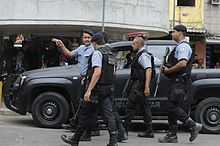
The battalions are based in major urban centers, and their companies and platoons are distributed according to population density in cities.
The Military Police of Rio de Janeiro is present in all cities of the State.
Commands and Battalions of Military Police
These are the Policing Area Commands and their respective battalions. Cities and neighborhoods indicate the location of their headquarters.
- 1st Policing Area Command – city of Rio de Janeiro
- 1st Battalion – Estácio
- 2nd Battalion – Botafogo
- 3rd Battalion – Méier
- 4th Battalion – São Cristovão
- 5th Battalion – Saúde
- 6th Battalion – Tijuca
- 13th Battalion – Downtown
- 16th Battalion – Olaria
- 17th Battalion – Ilha do Governador
- 19th Battalion – Copacabana
- 22nd Battalion – Maré
- 23rd Battalion – Leblon
- 1st Independent Company (Governor's Palace Guard) – Laranjeiras
- 2nd Policing Area Command – city of Rio de Janeiro
- 9th Battalion – Rocha Miranda
- 14th Battalion – Bangu
- 18th Battalion – Jacarepaguá
- 27th Battalion – Santa Cruz
- 31st Battalion – Barra da Tijuca
- 40th Battalion – Campo Grande
- 41st Battalion – Irajá
- 3rd Policing Area Command – city of Mesquita
- 15th Battalion – city of Duque de Caxias
- 20th Battalion – city of Mesquita
- 21st Battalion – city of São João de Meriti
- 24th Battalion – city of Queimados
- 34th Battalion – city of Magé
- 39th Battalion – city of Belford Roxo
- 4th Policing Area Command – city of Niterói
- 7th Battalion – city of São Gonçalo
- 12th Battalion – city of Niterói
- 25th Battalion – city of Cabo Frio
- 35th Battalion – city of Itaboraí

- 5th Policing Area Command – city of Volta Redonda
- 10th Battalion – city of Barra do Piraí
- 28th Battalion – city of Volta Redonda
- 33rd Battalion – city of Angra dos Reis
- 37th Battalion – city of Resende
- 6th Policing Area Command – city of Campos dos Goytacazes
- 8th Battalion – city of Campos dos Goytacazes
- 29th Battalion – city of Itaperuna
- 32nd Battalion – city of Macaé
- 36th Battalion – city of Santo Antônio de Pádua
- 7th Policing Area Command – city of Petrópolis
- 11th Battalion – city of Nova Friburgo
- 26th Battalion – city of Petrópolis
- 30th Battalion – city of Teresópolis
- 38th Battalion – city of Três Rios
Special Units
- Mounted Police Regiment;
- 2 Highway Patrol Battalions;
- 5 Environmental Protection Units;
- Pacifying Police Unit;
- Riot Control Battalion;
- Special Police Operations Battalion.
- Police Operations with Dogs Battalion (K-9 Unit)
- Railway Police Groupment;
- Airmobile Groupment;
- Maritime Groupment.
Administrative Commands
- Department of Education:
- Dom João VI Military Police Academy (to officer cadets);
- Military Police Formation Center (to non-commissioned officers and soldiers).
- Department of Logistic Support.
- Department of Personnel.
- Department of Finance.
- Department of Intelligence.
- Department of Social Assistance (welfare).
- Social Communication Center
- Communications and Informatic Center.
- Department of Health:
- Military Police Central Hospital, Rio de Janeiro city;
- Military Police Hospital, in Niteroi;
- 4 Clinics;
- Veterinary Center;
- Dentistry Center;
- Reahabilitation Center (Physical therapy).
Weapons
| Equipment | Type | Origin | Notes | Photo |
|---|---|---|---|---|
| FN FAL | Rifle | |
Standard | |
| ParaFAL | Rifle | |
Standard | |
| Heckler & Koch PSG1 | Sniper Rifle | |
special operations | |
| M16A2 | Rifle | |
special operations | |
| IMBEL MD2 | Rifle | |
special operations |  |
| M4 | Carbine | |
Standard | 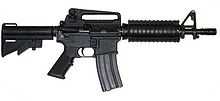 |
| AR15 | Carbine | |
Standard | |
| Taurus CT-30 | Carbine | |
Standard | |
| Remington Model 1100 | Shotgun | |
riot control | |
| Mossberg 500 | shotgun | |
riot control | |
| MP5 | submachine | |
special operations | 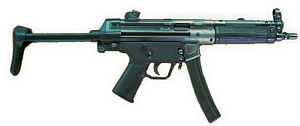 |
| Imbel MT-12 | submachine | |
Standard |  |
| TAURUS FAMAE in .40 | submachine | |
Standard |  |
| Taurus PT-100 | Pistol | |
Standard | 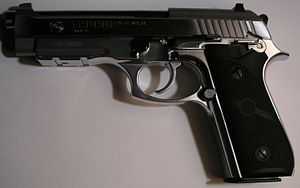 |
| Taurus PT 24/7 | Pistol | |
Standard |  |
| Taurus Model 605 | Revolver | |
Standard |  |
| Taser Pistol | Non-lethal weapon | |
Standard |  |
| Smoke grenade | Non-lethal weapon | |
riot control and special operations | |
| Riot gun | Non-lethal weapon | |
riot control and special operations |  |
Vehicles inventory
| Model | Manufacturer | Type | Notes | Photo |
|---|---|---|---|---|
| Gol G5 | Volkswagen | Patrol car | Being retired. Patrol rural | |
| Logan | Renault | Patrol car | Vehicle standard | 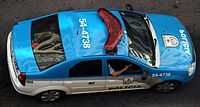 |
| Voyage G III | Volkswagen | Patrol car | Vehicle standard |  |
| Blazer | Chevrolet | Response car | Vehicle standard | 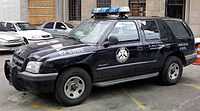 |
| Duster | Renault | Response car | Vehicle standard | |
| Hilux SW4 | Toyota Motor | Response car / Dog unit Car (K9) | Special police |  |
| Frontier D40 | Nissan | Multi-purpose car | Special police/ Highway patrol |  |
| Amarok | Volkswagen | Multi-purpose car | Riot police car |  |
| Master | Renault | Van | Riot police car | |
| Daily | Iveco | Van | Special police |  |
| Ducato | Fiat | Mobile station | Vehicle standard | |
| XT660 | Yamaha Motor Company | Patrol motorcycle | Standard | .jpg) |
| CB600 | Honda | Patrol motorcycle | Riot police | 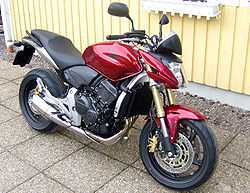 |
| Ford Cargo 815 | Ford Motor Company | Armored vehicle | Vehicle war on drugs | |
| VW Cargo 1722 | Volkswagen | Armored vehicle | Vehicle war on drugs | 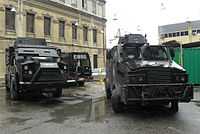 |
| Maverick | Paramount Group | Armored vehicle | Special operations | |
| Volkswagen Constellation | Volkswagen | Riot truck | Special operations/Water cannon | |
Aircraft inventory
| Aircraft | Type | Versions | In service | Photo | Note |
|---|---|---|---|---|---|
| Schweizer 300 | Training | Schweizer 300 CBi | 01 | |
Designated phoenix 6. |
| Eurocopter AS350 | Patrol helicopter | AS-350B3 | 06 (05 active) |  |
Designated phoenix 1,2,3,4,7,8. Phoenix 3 was shot down by narcotraffickers during gunbattle at the Morro dos Macacos in October 2009. |
| Bell Huey II | Special operations Armed helicopter |
Huey II | 01 | |
Designated phoenix 5. |
| Eurocopter EC145 | Patrol helicopter SAR |
EC145 | 01 |  |
Designated phoenix 9. |
| Piper PA-34 Seneca | Personal transport | PA-34 | 02 |  |
|
| Beechcraft Baron | Personal transport | Baron 58 | 01 | 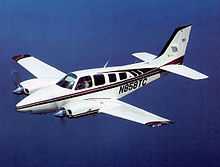 |
|
Uniforms
Since 1975, the PMERJ use dark grey blue in their uniforms or blue with black trousers. Special units have differenr uniforms for each service.
Ranks
The PMERJ has the same hierarchical classification[8] of the Brazilian Army, with another type of insignias.[9]
Ranks and insignia
| Title | Insignia |
|---|---|
| Colonel | |
| Lieutenant Colonel | |
| Major | |
| Captain | |
| First Lieutenant | |
| Second Lieutenant | |
| Aspirant | |
| Cadet or Student Officer |
|
| Sub-Lieutenant | |
| First Sergeant | |
| Second Sergeant | |
| Third Sergeant | |
| Corporal | |
| Private "A Class" | |
| Private "B Class" or Student Private |
No insignia |
All rank insignia are worn on the epaulettes of the shirt, except for sergeants, corporal and soldiers, which are worn on each sleeve, below the institutional patch.
Campaigns against crime
Gallery
-
PAC's – state division
-

Police officers – 1950s
-
Old PMERJ blazon (until 1975)
-

Old PMERJ blazon (between 1975 and 1983)
-

Police officers in 2002
-
Military police operation in Complexo do Alemão (November 2010)
-
.jpg)
Special Police Operations Battalion - Armored vehicle
-
.jpg)
Military Police in combating crime in the favelas of Rio de Janeiro
-
VW Cargo 1722 Military Police armored vehicle
-
Volkswagen Gol police car (2009)
-
.jpg)
Riot Control operation (2013)
-

Police station in Santa Marta favela
-

Riot control officer
-

PMERJ's mascot 1980-2000s
See also
- Rio de Janeiro State
- Civil Police of Rio de Janeiro State
- Military Police of Brazil
- Batalhão de Operações Policiais Especiais (BOPE)
- Brazilian Federal Police
- National Force of Public Safety
- Federal Highway Police
- Brazilian Civil Police
- Brazilian Armed Forces
- Military Police
- Gendarmerie
References
- ↑ Article 144 of Constitution of Brazil.
- ↑ Article 42 of Constitution of Brazil.
- ↑ Decree of December 10, 1801.
- ↑ Decree of May 13, 1809.
- ↑ Law of July 17, 1831.
- ↑ Law of October 10, 1931.
- ↑ Constitutional Reform of 1834, Article 15, § 11.
- ↑ Ordinance of the Ministry of the Army 340, October 4, 1971.
- ↑ Decree 3,568, March 02, 2001.
External links
| Wikimedia Commons has media related to Police of Rio de Janeiro. |
- Official website of Military Police of Rio de Janeiro State (in Portuguese)
| ||||||||||||||||||||||||||




